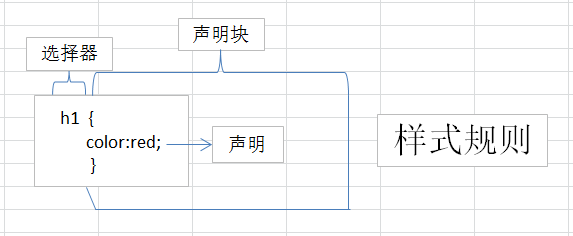第七章,CSS构造块
构造样式规则

为样式规则添加注释
理解继承
会被继承的CSS属性
层叠:当规则发生冲突时
属性的值
第八章,操作样式表
链接到外部样式表
<span style="color: #0000ff;"><span style="color: #800000;">link </span><span style="color: #ff0000;">rel</span><span style="color: #0000ff;">="stylesheet"</span><span style="color: #ff0000;"> href</span><span style="color: #0000ff;">="url.css"</span><span style="color: #0000ff;">></span></span>
创建嵌入样式表
应用内联样式表
样式的层叠和顺序
使用与媒体相关的样式表
第九章,定义选择器


按名称选择元素
按类或ID选择元素
按上下文选择元素
<span style="color: #800000;">.architect > p</span>{<span style="color: #ff0000;">
color</span>:<span style="color: #0000ff;">red</span>;
}
<span style="color: #0000ff;"><span style="color: #800000;">body</span><span style="color: #0000ff;">></span>
<span style="color: #0000ff;"><span style="color: #800000;">h1</span><span style="color: #0000ff;">></span><span style="color: #800000;">h1</span><span style="color: #0000ff;">></span>
<span style="color: #0000ff;"><span style="color: #800000;">p</span><span style="color: #0000ff;">></span><span style="color: #800000;">p</span><span style="color: #0000ff;">></span>
<span style="color: #0000ff;"><span style="color: #800000;">h2</span><span style="color: #0000ff;">></span><span style="color: #800000;">h2</span><span style="color: #0000ff;">></span>
<span style="color: #0000ff;"></span><span style="color: #800000;">body</span><span style="color: #0000ff;">></span></span></span></span></span>
h1与p是相邻同胞,h1与h2不是相邻同胞,p与h2是相邻同胞
<span style="color: #800000;">.architect p+p</span>{<span style="color: #ff0000;">
color</span>:<span style="color: #0000ff;">red</span>;
}
3、普通同胞结合符:~
<span style="color: #800000;">h1~h2</span>{<span style="color: #ff0000;">
color</span>:<span style="color: #0000ff;">red</span>;
}
选择第一个或最后一个子元素
<span style="color: #0000ff;"><span style="color: #800000;">ul</span><span style="color: #0000ff;">></span>
<span style="color: #0000ff;"><span style="color: #800000;">li</span><span style="color: #0000ff;">></span>1<span style="color: #0000ff;"></span><span style="color: #800000;">li</span><span style="color: #0000ff;">></span>
<span style="color: #0000ff;"><span style="color: #800000;">li</span><span style="color: #0000ff;">></span>2<span style="color: #0000ff;"></span><span style="color: #800000;">li</span><span style="color: #0000ff;">></span>
<span style="color: #0000ff;"><span style="color: #800000;">li</span><span style="color: #0000ff;">></span>3<span style="color: #0000ff;"></span><span style="color: #800000;">li</span><span style="color: #0000ff;">></span>
<span style="color: #0000ff;"><span style="color: #800000;">li</span><span style="color: #0000ff;">></span>4<span style="color: #0000ff;"></span><span style="color: #800000;">li</span><span style="color: #0000ff;">></span>
<span style="color: #0000ff;"></span><span style="color: #800000;">ul</span><span style="color: #0000ff;">></span></span></span></span></span></span>
<span style="color: #800000;">li:first-child</span>{<span style="color: #ff0000;">
color</span>:<span style="color: #0000ff;">red</span>;
}
选择元素的第一个字母或者第一行
按状态选择链接元素
按属性选择元素
| 选择器 | 属性值 |
| [attribute] | 匹配指定属性,不论值是什么 |
| [attribute="value"] | 完全匹配指定属性值 |
| [attribute~="value"] | 属性值是以空格分隔的多个单词,其中一个完全匹配指定值 |
| [attribute|="value"] | 属性值以 value- 打头 |
| [attribute^="value"] | 属性值以value开头,value为完整单词或单词一部分 |
| [attribute$="value"] | 属性值以value结尾,value为完整单词或单词一部分 |
| [attribute*="value"] | 属性值为指定值的子字符串 |
指定元素组
<span style="color: #800000;">h1,h2</span>{<span style="color: #ff0000;">
color</span>:<span style="color: #0000ff;">red</span>;
}
组合使用选择器
<span style="color: #800000;">em</span>{<span style="color: #ff0000;">
color</span>:<span style="color: #0000ff;">red</span>;
}<span style="color: #800000;">
.project em</span>{<span style="color: #ff0000;">
color</span>:<span style="color: #0000ff;">red</span>;
}<span style="color: #800000;">
.architect .project em</span>{<span style="color: #ff0000;">
color</span>:<span style="color: #0000ff;">red</span>;
}
<span style="color: #008000;">/*</span><span style="color: #008000;"> 以上实现相同效果,特殊性由低到高 </span><span style="color: #008000;">*/</span>
第十章,为文本添加样式
选择字体系列
指定替代字体
创建斜体
取消斜体
应用粗体格式
设置字体大小
设置行高
同时设置所有字体值
设置颜色
设置背景
控制间距
添加缩进
对齐文本
修改文本的大小写
使用小型大写字母
装饰文本
设置空白属性
 Why are HTML attributes important for web development?May 12, 2025 am 12:01 AM
Why are HTML attributes important for web development?May 12, 2025 am 12:01 AMHTMLattributesarecrucialinwebdevelopmentforcontrollingbehavior,appearance,andfunctionality.Theyenhanceinteractivity,accessibility,andSEO.Forexample,thesrcattributeintagsimpactsSEO,whileonclickintagsaddsinteractivity.Touseattributeseffectively:1)Usese
 What is the purpose of the alt attribute? Why is it important?May 11, 2025 am 12:01 AM
What is the purpose of the alt attribute? Why is it important?May 11, 2025 am 12:01 AMThe alt attribute is an important part of the tag in HTML and is used to provide alternative text for images. 1. When the image cannot be loaded, the text in the alt attribute will be displayed to improve the user experience. 2. Screen readers use the alt attribute to help visually impaired users understand the content of the picture. 3. Search engines index text in the alt attribute to improve the SEO ranking of web pages.
 HTML, CSS, and JavaScript: Examples and Practical ApplicationsMay 09, 2025 am 12:01 AM
HTML, CSS, and JavaScript: Examples and Practical ApplicationsMay 09, 2025 am 12:01 AMThe roles of HTML, CSS and JavaScript in web development are: 1. HTML is used to build web page structure; 2. CSS is used to beautify the appearance of web pages; 3. JavaScript is used to achieve dynamic interaction. Through tags, styles and scripts, these three together build the core functions of modern web pages.
 How do you set the lang attribute on the tag? Why is this important?May 08, 2025 am 12:03 AM
How do you set the lang attribute on the tag? Why is this important?May 08, 2025 am 12:03 AMSetting the lang attributes of a tag is a key step in optimizing web accessibility and SEO. 1) Set the lang attribute in the tag, such as. 2) In multilingual content, set lang attributes for different language parts, such as. 3) Use language codes that comply with ISO639-1 standards, such as "en", "fr", "zh", etc. Correctly setting the lang attribute can improve the accessibility of web pages and search engine rankings.
 What is the purpose of HTML attributes?May 07, 2025 am 12:01 AM
What is the purpose of HTML attributes?May 07, 2025 am 12:01 AMHTMLattributesareessentialforenhancingwebelements'functionalityandappearance.Theyaddinformationtodefinebehavior,appearance,andinteraction,makingwebsitesinteractive,responsive,andvisuallyappealing.Attributeslikesrc,href,class,type,anddisabledtransform
 How do you create a list in HTML?May 06, 2025 am 12:01 AM
How do you create a list in HTML?May 06, 2025 am 12:01 AMTocreatealistinHTML,useforunorderedlistsandfororderedlists:1)Forunorderedlists,wrapitemsinanduseforeachitem,renderingasabulletedlist.2)Fororderedlists,useandfornumberedlists,customizablewiththetypeattributefordifferentnumberingstyles.
 HTML in Action: Examples of Website StructureMay 05, 2025 am 12:03 AM
HTML in Action: Examples of Website StructureMay 05, 2025 am 12:03 AMHTML is used to build websites with clear structure. 1) Use tags such as, and define the website structure. 2) Examples show the structure of blogs and e-commerce websites. 3) Avoid common mistakes such as incorrect label nesting. 4) Optimize performance by reducing HTTP requests and using semantic tags.
 How do you insert an image into an HTML page?May 04, 2025 am 12:02 AM
How do you insert an image into an HTML page?May 04, 2025 am 12:02 AMToinsertanimageintoanHTMLpage,usethetagwithsrcandaltattributes.1)UsealttextforaccessibilityandSEO.2)Implementsrcsetforresponsiveimages.3)Applylazyloadingwithloading="lazy"tooptimizeperformance.4)OptimizeimagesusingtoolslikeImageOptimtoreduc


Hot AI Tools

Undresser.AI Undress
AI-powered app for creating realistic nude photos

AI Clothes Remover
Online AI tool for removing clothes from photos.

Undress AI Tool
Undress images for free

Clothoff.io
AI clothes remover

Video Face Swap
Swap faces in any video effortlessly with our completely free AI face swap tool!

Hot Article

Hot Tools

SublimeText3 English version
Recommended: Win version, supports code prompts!

Safe Exam Browser
Safe Exam Browser is a secure browser environment for taking online exams securely. This software turns any computer into a secure workstation. It controls access to any utility and prevents students from using unauthorized resources.

SecLists
SecLists is the ultimate security tester's companion. It is a collection of various types of lists that are frequently used during security assessments, all in one place. SecLists helps make security testing more efficient and productive by conveniently providing all the lists a security tester might need. List types include usernames, passwords, URLs, fuzzing payloads, sensitive data patterns, web shells, and more. The tester can simply pull this repository onto a new test machine and he will have access to every type of list he needs.

Notepad++7.3.1
Easy-to-use and free code editor

PhpStorm Mac version
The latest (2018.2.1) professional PHP integrated development tool







